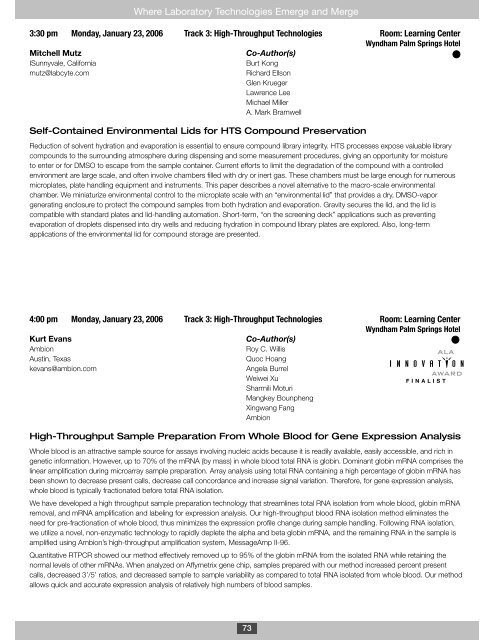LabAutomation 2006 - SLAS
LabAutomation 2006 - SLAS
LabAutomation 2006 - SLAS
You also want an ePaper? Increase the reach of your titles
YUMPU automatically turns print PDFs into web optimized ePapers that Google loves.
Where Laboratory Technologies Emerge and Merge<br />
3:30 pm Monday, January 23, <strong>2006</strong> Track 3: High-Throughput Technologies Room: Learning Center<br />
Wyndham Palm Springs Hotel<br />
Mitchell Mutz<br />
Co-Author(s)<br />
ISunnyvale, California<br />
Burt Kong<br />
mutz@labcyte.com<br />
Richard Ellson<br />
Glen Krueger<br />
Lawrence Lee<br />
Michael Miller<br />
A. Mark Bramwell<br />
Self-Contained Environmental Lids for HTS Compound Preservation<br />
Reduction of solvent hydration and evaporation is essential to ensure compound library integrity. HTS processes expose valuable library<br />
compounds to the surrounding atmosphere during dispensing and some measurement procedures, giving an opportunity for moisture<br />
to enter or for DMSO to escape from the sample container. Current efforts to limit the degradation of the compound with a controlled<br />
environment are large scale, and often involve chambers filled with dry or inert gas. These chambers must be large enough for numerous<br />
microplates, plate handling equipment and instruments. This paper describes a novel alternative to the macro-scale environmental<br />
chamber. We miniaturize environmental control to the microplate scale with an “environmental lid” that provides a dry, DMSO-vapor<br />
generating enclosure to protect the compound samples from both hydration and evaporation. Gravity secures the lid, and the lid is<br />
compatible with standard plates and lid-handling automation. Short-term, “on the screening deck” applications such as preventing<br />
evaporation of droplets dispensed into dry wells and reducing hydration in compound library plates are explored. Also, long-term<br />
applications of the environmental lid for compound storage are presented.<br />
4:00 pm Monday, January 23, <strong>2006</strong> Track 3: High-Throughput Technologies Room: Learning Center<br />
Wyndham Palm Springs Hotel<br />
Kurt Evans<br />
Co-Author(s)<br />
Ambion<br />
Roy C. Willis<br />
Austin, Texas<br />
Quoc Hoang<br />
kevans@ambion.com<br />
Angela Burrel<br />
Weiwei Xu<br />
Sharmili Moturi<br />
Mangkey Bounpheng<br />
Xingwang Fang<br />
Ambion<br />
F I N A L I S T<br />
High-Throughput Sample Preparation From Whole Blood for Gene Expression Analysis<br />
Whole blood is an attractive sample source for assays involving nucleic acids because it is readily available, easily accessible, and rich in<br />
genetic information. However, up to 70% of the mRNA (by mass) in whole blood total RNA is globin. Dominant globin mRNA comprises the<br />
linear amplification during microarray sample preparation. Array analysis using total RNA containing a high percentage of globin mRNA has<br />
been shown to decrease present calls, decrease call concordance and increase signal variation. Therefore, for gene expression analysis,<br />
whole blood is typically fractionated before total RNA isolation.<br />
We have developed a high throughput sample preparation technology that streamlines total RNA isolation from whole blood, globin mRNA<br />
removal, and mRNA amplification and labeling for expression analysis. Our high-throughput blood RNA isolation method eliminates the<br />
need for pre-fractionation of whole blood, thus minimizes the expression profile change during sample handling. Following RNA isolation,<br />
we utilize a novel, non-enzymatic technology to rapidly deplete the alpha and beta globin mRNA, and the remaining RNA in the sample is<br />
amplified using Ambion’s high-throughput amplification system, MessageAmp II-96.<br />
Quantitative RTPCR showed our method effectively removed up to 95% of the globin mRNA from the isolated RNA while retaining the<br />
normal levels of other mRNAs. When analyzed on Affymetrix gene chip, samples prepared with our method increased percent present<br />
calls, decreased 3’/5’ ratios, and decreased sample to sample variability as compared to total RNA isolated from whole blood. Our method<br />
allows quick and accurate expression analysis of relatively high numbers of blood samples.<br />
73
















